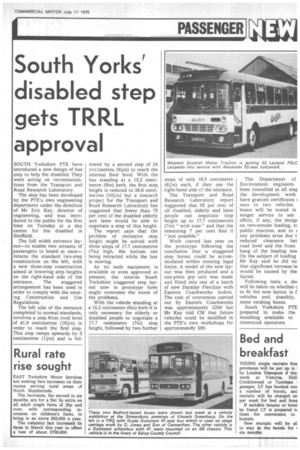South Yorks' disabled step gets TRRL approval
Page 41

If you've noticed an error in this article please click here to report it so we can fix it.
SOUTH Yorkshire PTE have introduced a new design of bus step to help the disabled. They were acting on recommendations from the Transport and Road Research Laboratory.
The step has been developed by the PTE's own engineering department under the direction of Mr Eric Kay, director of engineering, and was introduced to the public for the first time on Tuesday at a day centre for the disabled in Sheffield.
The full width entrance layout—to enable two streams of passengers to board at once— retains the standard two-step construction on the left, with a new three-step construction aimed at lowering step heights on the right-hand side of the entrance. The staggered arrangement has been used in order to comply with the existing Construction and Use Regulations.
The left side of the entrance completed to normal standards, involves a step from road level of 41.9 centimetres (161in) in order to reach the first Step. This step ramps upwards by 3 centimetres (11in) and is fol lowed by a second step of 24 centimetres (90n) to reach the internal floor level. With the bus standing at a 15.2 centimetre (6in) kerb, the first step height is reduced to 26.6 centimetres (101in) but •a research project for the Transport and Road Research Laboratory has suggested that fewer than 75 per cent of the disabled elderly and lame would be able to negotiate a step of this height.
The report says that the problem of excessive step height might be solved with three steps of 17.7 centimetres (7in) high, the bottom one being retracted while the bus is moving.
As no such equipment is available or even approved at present, the interim South Yorkshire staggered step layout now in prototype form might overcome the worst of the problems.
With the vehicle standing at a 15.2 centimetre (Gin) kerb it is only necessary for elderly or disabled people to negotiate a 17.7 centimetre (7in) step height, followed by two further steps of only 16.5 centimetre (61in) each, if they use the right-hand side of the entrance.
The Transport and Road Research Laboratory report Suggested that 93 per cent of all disabled, elderly and lame people can negotiate step height up to 17.7 centimetres (7in) "with ease" and that the remaining 7 per cent find it " just possible."
Work started last year on the prototype following the conclusion that ,a staggered step layout could be accommodated within existing legal limits. A model of the new layout was then produced and a one-piece grp unit was made and fitted into one of a batch of new Daimler Fleetline with Eastern Coachworks bodies. The cost of conversion carried out by Eastern Coachworks was approximately £200 but Mr Kay told CM that future vehicles could •be modified in the PTE's own workshops for approximately £80. The Department of Environment engineers been consulted at all stag the development work have granted certificates ness to two vehicles. buses will be tested in senger service to see effect, if any, the desigr on two-stream loading, tc public reaction, and to s any problems arise due t reduced clearance bet road level and •the front hang of •the leading nea On the subject of loading Mr Kay said he did no' that significant increase in would be caused by the layout.
Following tests a de( will betaken on whether c to fit the new layout in f vehicles and, possibly, some existing buses.
South Yorkshire PTE prepared to make the moulding available to interested operators.












































































































































